Ecosystem Question And Answers
Question 1. Difference Between the Grazing food chain and the Detritus food chain
Answer:
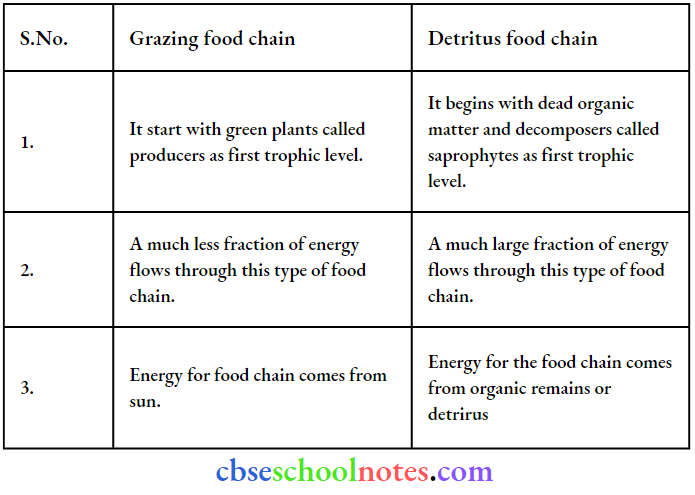
Question 2. Difference Between Litter And Detritus
Answer:
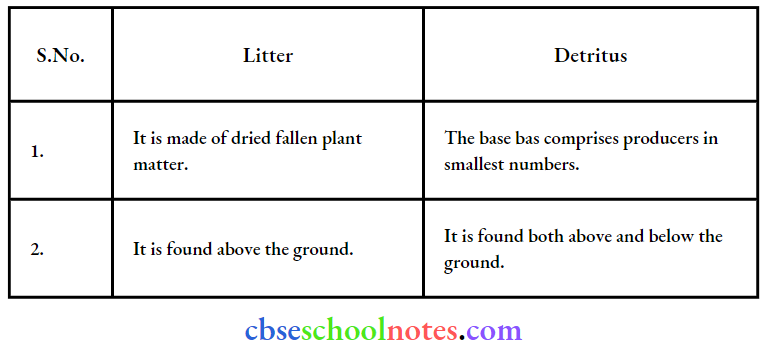
Question 3. Difference Between Food chain and Food web
Answer:

Question 4. Difference Between Production And Decomposition
Answer:
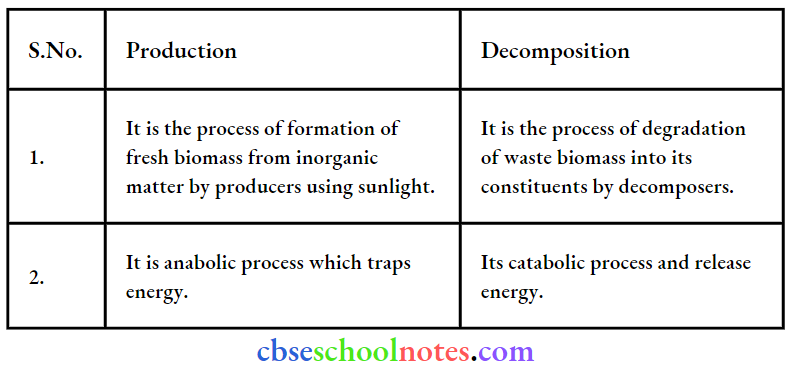
Question 5. Difference Between Upright and Inverted Pyramid
Answer:

Question 6. Difference Between Primary Productivity And Secondary Productivity
Answer:

Question 7. Describe the components of an ecosystem.
Answer:
An ecosystem consists of two types of components, ie., biotic or living and abiotic or non-living. There are three main types of biotic components based on the mode of obtaining their food- producers, consumers, and decomposers,

- Producers (autotrophs): are photosynthetic or autotrophic plants that synthesize their organic food from inorganic raw materials with the help of solar radiation. Common producers are algae, plants, and photosynthetic bacteria. Phytoplanktons are the producers of aquatic ecosystems.
- Consumers (heterotrophs): They are animals that feed on other organisms or producers to obtain their nourishment. Common consumers are deer, goats, etc.
- Decomposers: They are saprotrophs that obtain nourishment from organic remains. They release digestive enzymes to digest the organic matter. Common decomposers are detritivores,
- For Example: Earthworm.
Abiotic components of the ecosystem consist of non-living substances and factors that are as follows:
- Temperature
- Light
- Wind
- Humidity
- Precipitation
- Water

Question 8. Define ecological pyramids and describe with examples, pyramids of number and biomass.
Answer:
The relationship between producers and consumers at different trophic levels in an ecosystem can be graphically represented in the form of an ecological pyramid.
Structure: The base always represents tire producers or the first trophic level and the apex represents top-level consumers or the last.
Ecological pyramids are of three types;
- Pyramid of number
- Pyramid of biomass
- Pyramid of Energy
Pyramid of numbers: The relationship between producers and consumers in an ecosystem can be represented in the form of a pyramid in terms of several organisms at different trophic levels called the pyramid of numbers.
Note: It is inverted when you count several insects feeding on a big tree.
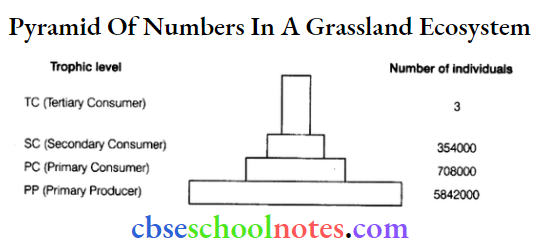
Pyramid of biomass: The relationship between producers and consumers in an ecosystem can be represented in the form of a pyramid in terms of biomass called a pyramid of biomass. It can be
- Upright, Example. in case of grassland ecosystem;
- Inverted, Example. in case of pond ecosystem as the biomass of fishes exceeds that of phytoplankton
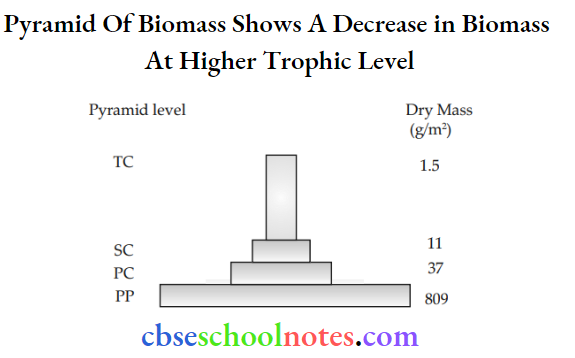
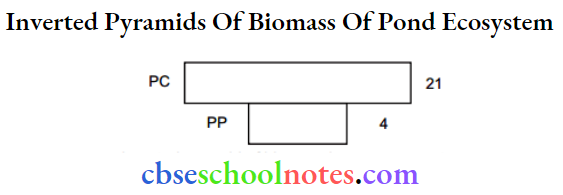
Question 9. What is primary productivity? Give a brief description of factors that affect primary productivity.
Answer:
Primary productivity is the rate of synthesis of biomass by producers, per unit time, per unit area through the process of photosynthesis.
The factors affecting primary productivity are the following
- Plant species inhabiting a particular area.
- Environmental factors:
- Sunlight: The sunlight directly regulates the primary productivity because the plants perform photosynthesis with the help of sunlight As the tropical region receives maximum sunlight it exhibits higher productivity.
- Temperature: Temperature regulates the activity of enzymes. So, the optimum temperature is required for the proper functioning of the enzyme.
- Moisture: Rain (humidity) is required for higher primary productivity. Deserts have the lowest primary productivity as dead soil is deficient in moisture.
Question 10. Define decomposition and describe the processes and products of decomposition.
Answer:
The process of breaking down complex organic matter into inorganic substances like CO, water, and nutrients is called decomposition. The raw materials for decomposition including dead plant remains like leaves, bark, flowers, and animal remains and their fecal matter are called detritus.
Steps of Decomposition
- Fragmentation: The process of breaking down detritus into smaller particles is called fragmentation, for example., as done by Earthworm (fanner’s friend).
- Leaching: The process by which water-soluble inorganic nutrients go down into the dead soil horizon and get precipitated as unavailable salts is called leaching.
- Catabolism: The enzymatic process by which bacterial and fungal enzymes degrade detritus to simpler inorganic substances is called catabolism.
- Humification: The process of accumulation of a dark-colored amorphous substance, called humus, that is highly resistant to microbial action and undergoes decomposition at an extremely slow rate is called humification. Humus being colloidal is the reservoir of nutrients.
- Mineralization: The process by which humus is further degraded by some microbes to release inorganic nutrients is called mineralization.
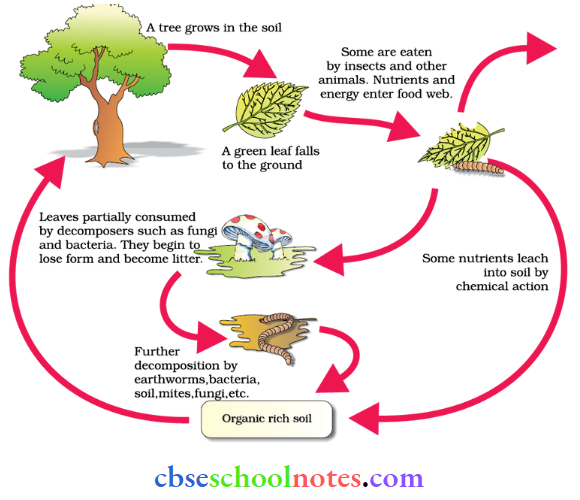
Question 11. Give an account of energy flow in an ecosystem.
Answer:
The sun is the only source of energy for all ecosystems on earth. Out of the total incident solar radiation, only 50% of it is photosynthetic active radiation (PAR).
- Plants capture only 2-10 % of the PAR and this small amount of energy sustains the entire living world. So, there is unidirectional flow of energy from the sun to producers and then to consumers
- The energy is transferred in an ecosystem, in the form of food which is degraded and loses a major part of food energy as heat during metabolic activities and only a very small fraction becomes stored as biomass
- This is correlated to the second law of thermodynamics, i.e., ecosystems need a constant supply of energy to synthesize molecules they require, to counteract the universal tendency towards increasing disorderliness. –
- The green plants in the ecosystem that can trap solar energy to convert it into chemical bond energy are called producers.
- All the animals that depend on food on plants are called consumers or heterotrophs.
- Consumers are divided into the following categories:
- Primary consumers: Animals that feed directly on plants, i.e., herbivores.
- Secondary consumers: Consumers that feed on primary consumers, i.e., carnivores.
- Tertiary consumers: Consumers that feed on secondary consumers
- Lindeman’s 10 percent law: At each step of the food chain, when food energy is transferred from one trophic level to the next higher trophic level, only about 10 percent of energy is passed on to the next trophic level. This is known as Lindeman’s 10 percent law given by Lindeman in 1942.
Ecosystem Multiple-Choice Questions
Question 1. Which one of the following has the largest population in a food chain?
- Producers
- Primary consumers
- Secondary consumer
- Decomposers
Answer: 1. Producers (decomposers can be maximum but they are excluded from the food chain)
Question 2. The second trophic level in a lake is
- Phytoplankton
- Zooplankton
- Benthos
- Fishes
Answer: 2. Zooplankton
Question 3. Secondary producers are
- Herbivores
- Producers
- Carnivores
- None of the above
Answer: 1. Herbivores
Read and Learn More Class 12 Biology Chapter Wise
Question 4. What is the percentage of photosynthetically active radiation (PAR) in the incident solar radiation?
- 100%
- 50%
- 1-5%
- 2-10%
Answer: 2. 50%
Ecosystem Fill In The Blanks
1. Plants are called Producers because they fix carbon dioxide.
2. In an ecosystem dominated by trees, the pyramid (of numbers) is an inverted type.
3. In aquatic ecosystems, the limiting factor for the productivity is Light.
4. Common detritivores in our ecosystem are Earthworms, ants, and mites
5. The major reservoir of carbon on earth is Oceans (71% dissolved carbon)
